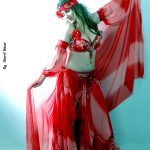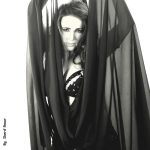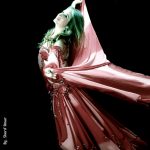The Seven Veils Dance
Nesma
Original works recorded by superb Egyptian musicians: the finest pieces to evoke the Magic of Belly Dance.
This album presents the best original music to dance the famous Dance of the Seven Veils. Although all the pieces on this disc were envisioned expressly for dancing with a veil, it is not necessary.
- Artista: Nesma
- Música: Ahmed Abdel Fattah
- Título: The Seven Veils Dance & other veil dances
- Magic Dances Volume 1
- Catalogue ref.: ND0702
The veil is an indispensable element in belly dance. It is in and of itself a subtle and magical element, through which we can reveal the body or choose to show only an enigmatic expression. The veil gives more presence and dramatic power to the dancer. With good reason, a performer in Egypt does not even fathom making her entrance without one. In the west, besides using this element to make entrances, many dancers give a great deal of importance to it, performing entire pieces with the veil.
Therefore, the pieces that we present here were created by professional dancers who, unable to find adequate music in the market, decided to produce their own pieces and contribute them to the musical panorama of Arab dance, so that they can be of use to other dancers around the world. Although all the pieces on this disc were envisioned expressly for dancing with a veil, it is not necessary. Additionally, we have here for the first time original music to dance the famous Dance of the Seven Veils.
Theme 1: Salome’s Seven Veils
This is one of the most mystical dances and the one which most awakens our curiosity. While there is no evidence of its existence in ancient times, many scholars have tried to find its origin.
The number seven is a magical number. For the Egyptians it represents vital energy. There are seven main chakras in yoga. There are also seven colors in the rainbow.
One of the legends that attempts to explain the origin of the Dance of the Seven Veils is the story in which Salome dances for King Herod. Although the Bible makes no allusion to this anecdote, it did serve as inspiration for Oscar Wilde’s play of the same name (1891). The film starring Rita Hayworth made this dance famous in the western world.
Theme 2: Salome’s Dream – Nay solo
This work is a solo for nay, the Middle Eastern flute which is a fundamental instrument in traditional Arabic music orchestras. It is an instrument that has been closely associated with veil dances for the lightness of its sound.
Theme 3: Mysterious Aida
This piece is a voyage to the world of the senses that Middle Eastern films evoke: the aromas of the marketplace in Baghdad, the sumptuous palaces and the sweet decadence of harems. This work features the oboe, an instrument which in the 20th century was used to suggest the ambience of the 1001 nights.
Theme 4: Mint Tea
On occasion, a melody´s simplicity can be as suggestive as a complex orchestral work. In this piece, two instruments converse, the kanoun and the nay, as they improvise over a rhythmic line.
Theme 5: Ishtar’s Seven Veils
Another story which serves to explain the origin of the dance of the Seven Veils is the myth of the goddess Ishtar. Led by her love for Tamuz, Ishtar travels to the underworld in search of her loved one. When she approaches the gates of the underworld, she must pass seven gates. At each gate, she must shed one article of clothing, a jewel or a veil. Once she has removed all her veils, Ishtar reveals her truth and finds her true love. Each veil symbolizes what we are hiding.
This second version of the dance of the Seven Veils has a very different style from the previous one. It is more modern and faster, and we chose to give it a pedagogical aspect giving each part of the piece a different rhythm (masmoudi, maksoum, malfouf, saidi, wahda, and ayoub) and a different instrument (nay, kanoun, violins, accordion, kawala, clarinet and tabla).
Theme 6: The Aroma of Shisha
This piece is an improvisation between two instruments, the kawala and the violin, over a maksoum rhythmic line.
Theme 7: The Great Veil of Friendship and Love
This piece was created for performances in large-staged spaces or for a large group of dancers with one lead dancer. It can also be performed with a large veil held by various dancers. The dance of the Great Veil is a creation of the famous choreographer, Mahmoud Reda.
The lyrics express the strength of love that unites borders, through the story of a Western woman who goes to an Arab country, falls in love with the land, and finds peace and love among its people.
Theme 8: Ishtar’s Dream – Nay solo
Another solo for the nay in a different scale than the last and which complements it.
Theme 9: The Great Veil of Friendship and Love – Instrumental Version
This piece is an instrumental version of the previous work. Here, an instrumental soloist substitutes the voice and this version is shorter, offering the dancers other possibilities.
Theme 10: The Great Veil of Friendship and Love Finale
This theme is a farewell to the previous piece, followed by a short repetition of the theme to allow performers to bow to the audience and leave the stage.
Credits
Production and Direction: María Paloma García-Cabanes
Recorded, mixed and mastered by Ahmed Abdel Fattah at Magic Sound Studio, Cairo, Egypt 2006
Musicians:
Violins
Yehi El Moguy # 1, 7
Moustafa Helmy # 1, 7
Mohamed Ismail # 1, 7
Osama El Asabgy # 1, 7
Saad Mohamed # 1, 7
Ahmed Kamal # 1, 7
Nabil Gromen # 5, 3
Moustafa Abdel Aziz # 5, 3
Tamer Faizy # 5, 3
Ibrahim Radio # 5, 3
Moustafa Abou Sheffa # 5, 3
Violin Soloist
Tawfiq Helmy # 6
Cello
Taha El Said # 1, 7
Yasser Taha # 5, 3
Oboe
Wesam Ahmed # 3
Kanoun
Maguid Naem # 1, 3, 4, 5, 7
Kawala
Abdala Helmy # 1, 4, 5, 6, 7
Accordion
Ahmed Abdel Fattah # 1, 5
Clarinet
Mohamed Yosef # 5
Double bass
Salah Ragab # 3, 5
Atef Sherif # 1, 7
Req
Mohamed Sobhy # 1, 2, 3, 4, 5, 6, 7, 8, 9, 10
Oud
Mohsen Mohamed # 1, 5
Flute
Hessa Ragab # 1, 7
Chords
Ahmed Abdel Salam
Osama El Khouly
Eman Soliman
Nahid Sultan
Singer
Hoda Ahmed

























